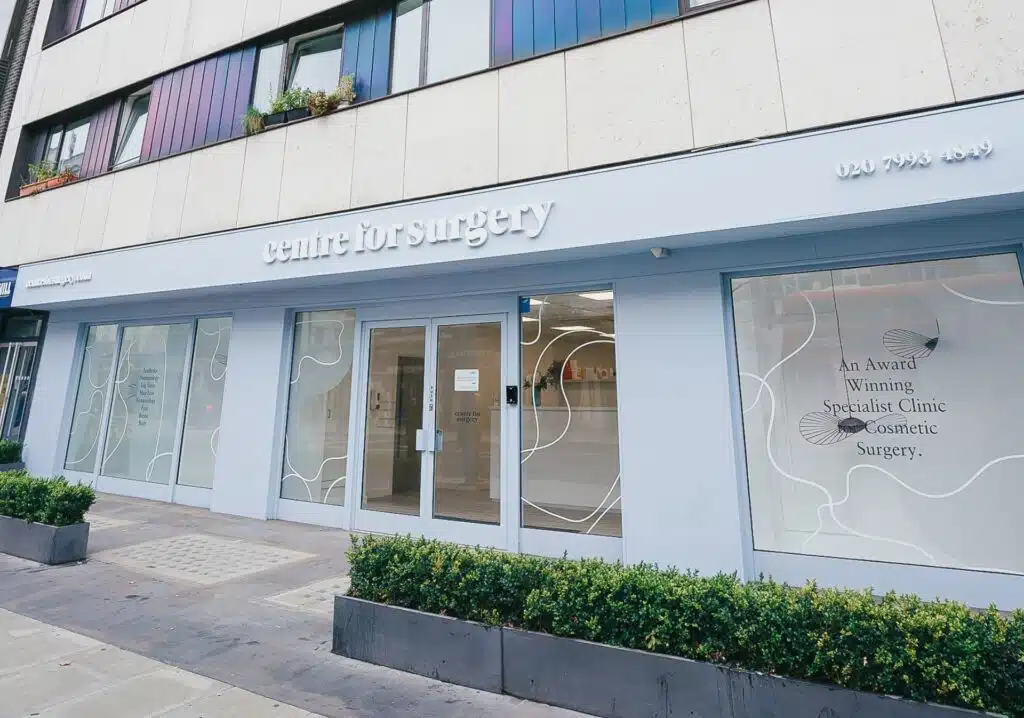Perineoplasty: London & UK
Perineoplasty is designed to reconstruct the perineum to help support the vagina and pelvic floor musculature. The perineum is the area located between the vagina and the anus. The structure of the perineum can be disrupted by childbirth, traumatic injury, significant weight loss and the natural ageing process. These factors can result in the vaginal opening enlarging and appearing widened.
RELATED: Cosmetic Gynaecology Surgery
Perineoplasty surgery is can tighten the perineal area and narrow the vaginal opening. Areas of scar tissue which has occurred as a result of childbirth or trauma can be effectively reconstructed. The procedure can effectively improve both the appearance of the perineum and improve its function for a significant boost in self-confidence.
RELATED: What is vaginal tightening surgery?
What is Perineoplasty?
Perineoplasty, also known as perineorrhaphy, is a surgical procedure that involves the repair and rejuvenation of the perineum. The perineum is the area located between the vaginal opening and the anus. This procedure is commonly performed to address physical discomfort, sexual dysfunction, or aesthetic concerns related to the perineal area.
RELATED: What is perineoplasty?
Perineoplasty may be performed for various reasons. Some women opt for the procedure to correct perineal damage caused by childbirth, trauma, or ageing, which can result in laxity or asymmetry. It may also be performed to address issues such as dyspareunia (painful sexual intercourse), rectocele (bulging of the rectum into the vagina), or to enhance sexual satisfaction by tightening the vaginal opening.
During a perineoplasty, the surgeon makes an incision in the perineum and then tightens the underlying muscles and tissues, before excising any excess skin. The wound is then closed with sutures. This procedure can enhance the appearance of the perineal area and tighten the vaginal opening, leading to improved self-esteem and sexual function for many women.
Benefits of Perineoplasty Surgery
Perineoplasty can offer several benefits to suitable candidates:
Enhanced Sexual Satisfaction
By tightening the vaginal opening and improving muscle tone, perineoplasty can often enhance sexual sensation and satisfaction.
Improved Appearance
The procedure can help to improve the appearance of the perineum and vaginal area, which can boost self-esteem and confidence, particularly in intimate situations.
Resolution of Discomfort
If excess skin or lax perineum has been causing physical discomfort, irritation, or pain during intercourse, perineoplasty can effectively address these issues.
Rectocele Repair
A rectocele, where the rectum bulges into the vagina, can cause discomfort and difficulties with bowel movements. Perineoplasty can be performed to correct this condition, alleviating symptoms.
Improved Quality of Life
The combined effects of enhanced sexual satisfaction, improved appearance, and the resolution of discomfort can lead to an overall improvement in quality of life for many women who undergo this procedure.
Am I Suitable for Perineoplasty?
Individuals considering perineoplasty should have realistic expectations about the outcomes of the surgery and understand the procedure’s scope. Suitable candidates often include those who:
Experience Physical Discomfort or Pain
If the structure of the perineum causes discomfort during daily activities or sexual intercourse, perineoplasty might offer relief by reconstructing the area for improved comfort and function.
Have Aesthetic Concerns
For those who are self-conscious or unhappy with the appearance of their perineum due to stretching or deformities caused by childbirth, ageing, or injury, perineoplasty can enhance the aesthetic appearance, contributing to an improved body image and self-esteem.
Seek Improvement in Sexual Function
Some individuals may find that changes in the perineum’s structure affect sexual satisfaction or comfort. By tightening and restoring the area, perineoplasty can potentially enhance sexual function.
Are in Good Overall Health
As with any surgical procedure, candidates should be in good health to minimise the risk of complications during and after surgery. This includes having no active infections or serious health conditions that could impair healing.
Have Completed Their Family
Individuals should consider completing their family before undergoing perineoplasty, as future pregnancies can reverse the effects of the procedure.
Have Realistic Expectations
Understanding the potential outcomes and limitations of perineoplasty is crucial. A detailed consultation with a qualified surgeon at Centre for Surgery can help set realistic expectations.
Perineoplasty Procedure
Perineoplasty, also known as perineorrhaphy, is a surgical procedure that repairs and tightens the perineum, which is the area of skin and muscle located between the vaginal opening and the anus. The goal of perineoplasty is to improve the appearance and functionality of the perineum after it has been stretched or damaged, typically as a result of childbirth.
RELATED: Vaginoplasty FAQs – Q&A about Vaginal Tightening Surgery
The following is a detailed description of the perineoplasty procedure:
Anesthesia
Perineoplasty is typically performed under general anaesthesia or local anaesthesia with sedation, depending on the individual needs and preferences of the patient.
Incision
The surgeon will make a small incision in the perineum, usually along the midline. This incision allows the surgeon to access the underlying muscles and tissues.
Repair of muscles
The surgeon will then repair and tighten the underlying muscles and fascia to provide support to the perineum.
Suture closure
The skin will then be closed with sutures, which will help to restore the appearance and function of the perineum.
Recovery
After the procedure, the patient will need to rest and avoid any strenuous activities for several weeks. The patient will also need to attend follow-up appointments with the surgeon to monitor the healing process.
Recovery after Perineoplasty
As with all types of cosmetic gynaecology procedures, it is important to take time out for adequate rest and recovery after perineoplasty to ensure your healing progresses smoothly and with minimal risk of complications occurring.
It is normal to develop bruising and swelling during the first few days after surgery. The application of cold packs can help to minimise swelling, and any discomfort can be effectively controlled with prescription painkillers. It may be useful to immerse the perineal area in shallow warm water for a pleasant soothing sensation in the first two weeks after surgery.
It is important to follow your surgeon’s post-operative instructions in full, including the following:
- Avoid inserting tampons into the vagina for a minimum of six weeks.
- Sexual intercourse should be avoided for six weeks.
- Strenuous exercise, including lifting heavy objects should be avoided for a minimum of four weeks.
- Make sure to keep well hydrated by drinking plenty of water and eating lots of green vegetables to prevent constipation.
- External sanitary pads are useful for absorbing any minor vaginal bleeding.
- The area of surgery should be kept clean and dry and you should avoid rubbing the area after washing. Patting the area dry is the preferred technique.
- Your surgeon uses dissolvable stitches which do not need to be removed at your postoperative check-up appointments.
Once your recovery is complete after perineoplasty surgery, your surgeon may recommend Kegel exercises to increase pelvic floor strength. The best types of exercises will be shown to you, which you can be carried out at home.
Risks of Perineoplasty
As with any type of surgical procedure, perineoplasty carries certain risks and complications and your surgeon will discuss this at your consultation. Recognised risks of perineoplasty surgery include:
- Painful sexual intercourse or dyspareunia
- Bleeding
- Wound infection
- Constipation
- Inadequate amount of tightening sufficient to increase vaginal sensitivity
Although these risks are rare, by choosing to have your procedure at Centre for Surgery, our surgeons are trained to manage any potential complications of perineal repair.The risk of complications occurring can be minimised by following your surgeon’s postoperative instructions in full.
How Much Does a Perineoplasty Cost?
Perineoplasty surgery is not available on the NHS and is not covered by most private medical insurance policies. Patients would have to pay privately to have the procedure carried out.
RELATED: How much does vaginal rejuvenation cost?
Perineoplasty prices will depend on whether the procedure is performed alone or combined with vaginoplasty or another cosmetic gynaecology procedure such as labioplasty. The procedure can be carried out under a local anaesthetic or general anaesthetic, with prices under general anaesthetic costing more.
Are perineoplasty and vaginoplasty the same thing?
Perineoplasty and vaginoplasty are related but separate surgical procedures.
Perineoplasty is a procedure that repairs and rejuvenates the perineum, which is the area between the vaginal opening and the anus. This procedure can be performed to address issues such as tears or stretching that may occur during childbirth or to tighten the vaginal opening for cosmetic or functional reasons.
Vaginoplasty, on the other hand, is a procedure that involves tightening and reshaping the vaginal walls. This procedure can be performed to address issues such as weakened or stretched vaginal walls that can occur as a result of ageing, childbirth, or other factors.
While both procedures can be performed separately, they can also be combined into a single procedure depending on the individual patient’s needs and goals. In some cases, perineoplasty may be performed in conjunction with other female genital surgical procedures, such as labiaplasty or clitoral hood reduction.
Perineoplasty Surgery in the UK: Discover Excellence at Centre for Surgery
Centre for Surgery stands as a beacon of excellence and innovation in the realm of plastic surgery within the UK. Specialising in a wide array of surgical procedures, we are particularly renowned for our expertise in perineoplasty surgery. At our state-of-the-art clinic located in the heart of London, we combine cutting-edge technology with unparalleled surgical skill to deliver outcomes that are not just transformative but also tailored to the individual needs and aspirations of our patients.
Unmatched Expertise and Patient-Centric Care
At Centre for Surgery, we pride ourselves on our holistic approach to patient care. From the initial consultation through to post-operative follow-up, our dedicated team ensures every patient receives the highest level of support and guidance. Our surgeons are not only leaders in their field but also compassionate professionals who understand the importance of empathy and patient comfort.
Why Choose Us for Your Perineoplasty Surgery
- Expertise: Our surgical team possesses extensive experience in perineoplasty, ensuring you are in the safest hands.
- Personalised Care: We believe in customising your treatment plan to fit your unique needs, ensuring optimal outcomes.
- Advanced Technology: Utilising the latest surgical techniques and technologies for minimal discomfort and faster recovery.
- Comprehensive Support: From consultation to post-surgery care, our team is with you every step of the way.
Hear From Our Satisfied Patients
- Testimonial 1: “My experience at Centre for Surgery was exceptional. From the knowledgeable staff to the pristine facility, I felt supported throughout my perineoplasty journey. The results have truly exceeded my expectations.” – Emily R.
- Testimonial 2: “Choosing Centre for Surgery for my perineoplasty was the best decision I’ve made. The care and attention to detail from the team made my recovery smooth, and I’m thrilled with the outcome.” – Sarah J.
- Testimonial 3: “The professionalism and expertise at Centre for Surgery are unparalleled. My surgeon was incredible, making me feel at ease and ensuring a fantastic result from my perineoplasty.” – Lauren K.
Book Your Consultation Today
Embarking on your surgical journey with Centre for Surgery begins with a consultation. Contact us today to discuss your perineoplasty needs and explore how we can help you achieve your desired outcomes.
- Phone: 0207 993 4849
- Email: contact@centreforsurgery.com
- Address: 95-97 Baker Street, London W1U 6RN
Additional Resources
For more detailed information about our clinic and the breadth of procedures we offer, including perineoplasty, visit our About Us page. Explore our Plastic Surgery Blog for insights and updates on the latest trends and techniques in the field. If you have questions, our comprehensive Clinic FAQs page is a great resource. Finally, learn about our Finance Options, including 0% APR with Chrysalis Finance, making your transformation both achievable and affordable.
Visit our Baker Street Clinic page for more information about our prime location and how to reach us.
At Centre for Surgery, your journey towards self-improvement is our top priority. We’re dedicated to providing you with a safe, comfortable, and fulfilling experience.
FAQs
-
What is perineoplasty?Perineoplasty involves surgical repair of the perineal muscles and connective tissue which supports the vaginal opening.
-
Is a vaginoplasty the same as perineoplasty?Whilst there are similarities in some areas, perineoplasty and vaginoplasty are two distinct procedures. Vaginoplasty is also known as vaginal tightening surgery and may be carried out to treat a loose vagina or vaginal laxity, most commonly as a result of childbirth. In rare cases, vaginoplasty may be part of a gender affirmation procedure. Women with damage to the vagina can have this repaired with a vaginoplasty. Some people may be born without a vagina, and vaginoplasty surgery can help to create a new one. Perineoplasty surgery is designed to improve function and restore tightness to the perineal muscles which are located at the vaginal opening of the vagina and perineal area. A vaginoplasty is commonly combined with a perineoplasty in the same procedure.
-
Does perineoplasty tighten the vagina?While perineoplasty can improve the appearance and functionality of the perineum, it is not specifically designed to tighten the vagina.
Vaginoplasty, on the other hand, is a surgical procedure that specifically tightens the vagina. It is typically performed for women who have experienced significant vaginal laxity, which can occur as a result of natural ageing, childbirth, hormonal changes, or other medical conditions.
In some cases, a combination of perineoplasty and vaginoplasty may be performed to achieve optimal results. This will depend on the individual needs and goals of the patient and should be discussed with a qualified surgeon who specialises in genital surgery.
Although perineoplasty and vaginoplasty can have benefits, they are not without risks, and the procedures may not be right for everyone. Carefully consider your goals and expectations and to discuss your concerns with your surgeon, to ensure that you make an informed decision about whether perineoplasty or vaginoplasty is the right choice for you. -
Why do women get a perineoplasty?Most women who choose to have perineoplasty do so to narrow the vaginal opening by getting rid of loose skin. A wide vaginal opening may result in reduced stimulation during intercourse and may affect the ability to achieve sexual climax. Damage to the perineal muscles may also be present from childbirth and may cause urinary incontinence.
Reasons to have a perineoplasty include:
Wide vaginal opening with loose skin
Reduced sensation during sexual intercourse
Excessive and painful scar tissue after uncontrolled tearing during vaginal delivery or after an episiotomy
Vaginal pain and discomfort with persistent irritation
Reduced self-confidence
Reduced sexual drive
Urinary incontinence
Faecal incontinence -
Where is the perineum and what is its function?The perineum measures approximately 3 to 4 cm and is located between the vaginal opening and the anus. The perineum is key to the proper function of the vaginal opening. It is composed of connective tissue and muscles that help to tighten the opening of the vagina and provide adequate support for the internal reproductive organs. The perineum also functions to narrow the vaginal opening during penetrative sexual intercourse.
-
What causes damage to the perineum?Childbirth is the most common cause of damage to the perineum. When women have vaginal childbirth, the soft tissues of the vagina canal must stretch significantly to accommodate the unrestricted passage of the baby to the outside world. Multiple childbirths significantly increase the risk of developing vaginal laxity and a wide vaginal opening.
During a traumatic vaginal delivery, the soft tissues of the vagina matey in an uncontrolled fashion or an episiotomy may be required to facilitate childbirth. In both cases, women are more likely to develop scar tissue which may be painful and tender. Women may also notice a reduction in sensation and discomfort during sexual intercourse.
The development of vaginal laxity or perineal damage may also be caused by the following:
Significant weight loss or weight gain
Traumatic injury to the vagina or perineum
Ageing
Genetics
Strenuous exercise
Pathology affecting the female genitalia such as malignancy
Long-distance cycling or horseback riding -
Why does the perineum get damaged?Vaginal delivery is most commonly responsible for damage to the perineum. During vaginal childbirth, the vaginal tissues must stretch to accommodate the passage of the baby. In some cases, the perineum will tear, which may require an episiotomy to reconstruct the perineum. In some cases, bleeding and swelling after childbirth may result in disruption of the vital connective tissue structures which support the vagina. This can lead to significant weakening over time and lead to the appearance of a gaping or wide vaginal opening.
Painful scar tissue may also develop and this may result in pain and discomfort during sexual intercourse. -
What problems can perineal damage cause?The consequences of perineal damage can result in a variety of symptoms including vaginal laxity which may be experienced during sexual intercourse, vaginal irritation, urinary incontinence, faecal incontinence, recurrent vaginal infections and a feeling of heaviness in the vaginal area when standing for long periods of time.
-
Does perineoplasty tighten the vagina?Yes. Perineoplasty is highly effective for tightening the vaginal opening. The procedure is not designed to tighten the vaginal canal. Vaginoplasty is more appropriate for tightening of the vaginal canal.
-
What does perineoplasty surgery involve?Perineoplasty can be performed under local or general anaesthesia, depending on the required surgical correction.
The surgeon will fix your vaginal opening by surgically removing loose and damaged skin, and then reconstructing the weakened muscles that support the perineum. Perineoplasty involves making a V-shaped incision located at the lower part of the vaginal opening, removing any scarred tissue and repairing the deeper muscles before closing the incisions with dissolvable stitches. -
How long does perineoplasty surgery take to perform?Perineoplasty surgery typically takes between 1 to 2 hours to perform. However, the exact duration of the procedure can vary depending on the complexity of the case and the individual patient's anatomy.
-
Is perineoplasty painful?Perineoplasty is most commonly carried out under a general anaesthetic and you will be unable to feel any discomfort during the procedure. The surgeon will inject a local anaesthetic whilst you were asleep which will minimise any discomfort you may experience after the procedure. Your surgeon will also prescribe prescription painkillers to ensure you are comfortable during the recovery phase after perineoplasty.
-
What is the recovery time after perineoplasty?Recovery after perineoplasty is quick and with minimal risk of complications. You will be advised to avoid penetrative sexual intercourse for six weeks and to avoid any activities that may irritate the area of surgery. Any pain or discomfort can be easily controlled with over-the-counter painkillers such as paracetamol.
-
How do I know if I need a perineoplasty?Should you have any worries regarding suboptimal healing after vaginal childbirth, or should you get frequent vaginal or urinary tract infections, or find the act of vaginal penetration during sexual intercourse challenging due to excessive looseness or tightness, or if you're troubled by diminished sensation during coitus, or face difficulty in bowel evacuation, it's likely that you might be an ideal candidate for perineoplasty. Should any queries or doubts occur to you, we warmly encourage you to voice them, and we will be more than ready to assist you in exploring and comprehending your potential alternatives in detail. It is our foremost priority to ensure you are provided with all the necessary information, aiding you in making the most well-informed decision for your unique situation.














